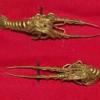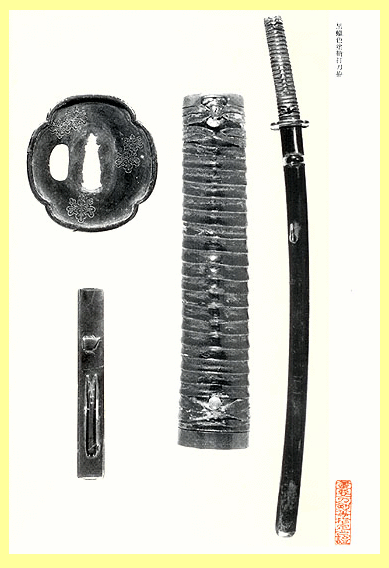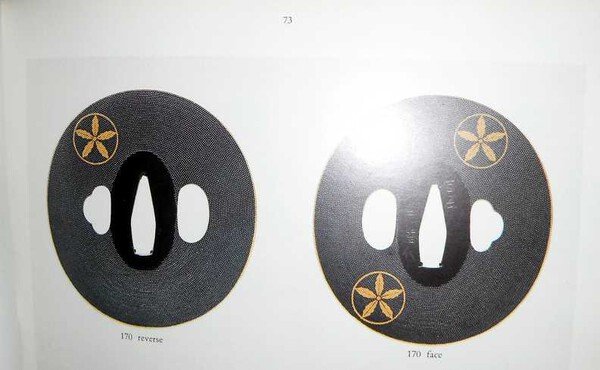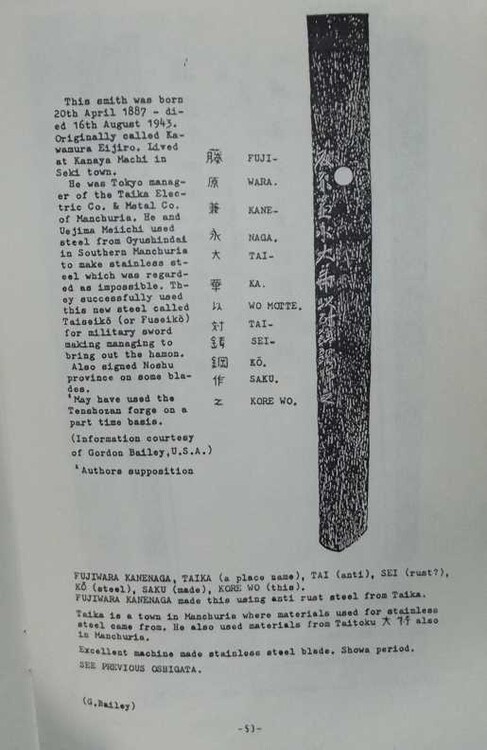-
Posts
435 -
Joined
-
Last visited
Content Type
Profiles
Forums
Events
Store
Downloads
Gallery
Everything posted by Lance
-
I contacted Fred and he was kind enough he sent me the pictures of the koshirae, whoever owns them must be very happy to have such a great old set of mounts! Lance
-
Besides Sudareba, Mishina smiths also used Kikusui, or chrysanthemum on a stream hamon. Maybe this is part of what led to the Kantei to Hisamichi? Below are one of your pictures, and oshigata from USAGIYA website at the link below describing Kikusui, and a little historical background. To me they look similar although the oshigata doesn't specify a smith......Or maybe someone can translate the part of your papers where the hamon is listed to see how it's described? http://www.ksky.ne.jp/~sumie99/kikusui.html Regards, Lance
-
Aside from a set of mounts that were specifically made from matching fittings by an artist, I've been told/read that to be papered koshirae needed to be assembled and used together historically speaking? For example an original Edo period koshirae might have a Momoyama period tsuba, but as long as it was "period and not a later parts sword , it was a good candidate. How this is judged must be pretty tough considering how easy it is to swap out parts, especially tsuba or kogai/kodzuka. Regards, Lance
-
Thank you Morita-san. I wasn't thinking Shoami due to reading their early tsuba weren't signed, and I thought this one was older. Best Regards, Lance
-
I have a tsuba I've been puzzling over that I was hoping for some assistance with: It's a round larg (ish) thin plate like a tosho tsuba with a very small taper towards the edge, in hand the taper is barely noticeable compared to pictures Hitsu-ana size and shape looks original, like what I've seen on older tosho tsuba as well and overall I'd guess Momoyama period. Thing is, most tosho or armorer tsuba I've seen and have/had in my collection used small sukashi designs, with some small or abstract designs like Heianjo or Onin. This one has multi metal soft inlays and a sage sitting on a log, fishing under trees/bamboo with distant mountains on the reverse. It's signed but very worn as is the tsuba in general, I tried some close ups and copying (poorly) parts of the mei I could see, attached pics below. I'd be grateful if someone can translate it or can see something in the mei familiar enough to point me in the right direction? Measurements 3 1/4 inch or 8.255 cm wide 3/16 inch or 4.7625 mm thickness at rim Thank you in advance for your time, Lance
-
I think referring to a sword like this as being made for Iai-to it would/could still be considered true Nihonto, just not made and finished to the same level as Shinsakuto "art swords" Regards, Lance
-
It's not the price of the real thing, but the only logical conclusion is at some point someone thought it would either be an easier sale or worth more as an "old sword" with a big name and cutting test than a new sword/used one by a modern smith. Otherwise it would be unsigned or have the real smith's signature. Regards, Lance
-
Nice one, I recently saw a set of round button shaped menuki with a similar finish, and thought they looked like they were was made to resemble some kind of silk(?) fabric as well. I Attached are a couple images of a tsuba from part one of the Christie's Compton auction, lot 170, page 73. This one is just 3 mon on a shakudo base but same technique, described as Yoshioka school, might help point to them or a different group that was influenced by them? If you have the catalogs the oversized pictures in the catalog make for a much better comparison than my poor photography. Regards, Lance
-
I was under a couple different impressions of what an "utushi" referred to: In modern times it's a recreation of a specific noted or famous sword, not one merely in the style of the smith or school? The small number I've seen always had the real smith's art name with some even mentioning the sword they were attempting to recreate as part of the signature. In the book "The New Generation of Japanese Sword smiths" there are interviews with the smiths, and when they mentioned making swords in the style of a school or smith they didn't mention doing an utushi, they said they were ready to challenge Soshu or Bizen den, etc. I don't know if it was just the way it was translated for western readers but it does sound different (I've read similar online or in other books but that's one that sticks out) During Samurai/Edo era utushi had a different meaning, copies of swords by famous Koto smiths were were made to be given as gifts as there's only so many Masamune to give? The sword that was posted does look to be modern, my only guess as to why it was altered is that maybe the secondary market on Shinsakuto isn't as great as antiques? and they aren't looked at in the same way when it comes to the history or as an investment, kind of like depreciation of new cars, a new Camaro/Mustang won't be worth as much in 5 years as the old muscle cars of the 1960's? Regards, Lance
-
Maybe Brian/moderators, or the first poster in this thread could edit in a link to Edo Period Corner part 1 in the first of this thread? I'd hate to see it get buried, as there's so much great stuff in there. Regards, Lance
-

about to go pick up this blade, mei looks right
Lance replied to gun addict's topic in Military Swords of Japan
Here's another link about Koa-Isshin Mantetsu. They weren't actually made of rail steel, although the steel for them was produced by the same factory that did. While not true gendaito they seem to be the best quality non-traditionally made swords during Showa period that you're likely to find. http://home.earthlink.net/~steinrl/koa.htm Regards, Lance -

Tanto from 1536 listed on ebay.
Lance replied to bmoore1322's topic in Auctions and Online Sales or Sellers
I think if an item is listed under antiques, art, or collectable categories there's no listing fee unless it sells, definitely a little overpriced though. Regards, Lance -
Generally all fittings should be mounted as if it was being worn: menuki and kashira facing edge up if worn like a katana, the top of the mountain, boat or the dog's head would be facing up same as the blade, if it was on a tachi it would be the opposite, head's up, blade down. Sometimes there might be exceptions, like if the dogs are playing thay might be belly up, or Shishi on a kashira might be posed with their heads lower than their body. Regards, Lance
-
Depending on how long ago you showed it to him, maybe Meiji-Taisho era swords weren't appreciated as much at the time? Also added a link to an old(?) article I came across a while ago from the Metroplolitan Museum of Art in NY, on Gassan Sadakazu http://www.metmuseum.org/pubs/journals/ ... nnered.pdf Regards, Lance
-
Hello David, I wasn't trying to say say it was Umetada work, the idea of pointing in the right direction was maybe looking into who made tsuba in the style/copied Umetada work during late Edo period, in combination with the style of inlay might be of some use? Always happy to be corrected, as it's part of the learning process. Regards, Lance
-
Not saying it's the same artist as your tsuba, but it maybe it will point you in the right direction? Other mokume tsuba I've seen were cut in lower relief than these 2 http://www.silk-road.us/shigyosh1.html Regards, Lance
-
Maybe they were part of the polisher's formula for nugui, I think applying it is the last or second to last step in polishing process? Regards, Lance
-

Fujiwara Kanenaga, anti-rust steel and "real hamon".
Lance replied to Bruno's topic in Military Swords of Japan
I assumed they were water quenched because the hamon was so unlike what you'd see on oil quenched Seki/Showato, I think the only way to know for sure what the full construction medthods used would be if a news or research article written back then existed and turned up? Regards, Lance -

Fujiwara Kanenaga, anti-rust steel and "real hamon".
Lance replied to Bruno's topic in Military Swords of Japan
Hi Bruno, Both swords were signed as being made from anti-rust steel. I attached a page with some information from one of the Fuller & Gregory's Oshigata books, (104 Unusual, Rare, and Interesting Oshigata from Japanese Sword Blades) Both were nearly identical to the example here, if I remember correctly the ones I had might have used Noshu or Mino in the signature. Hope this is useful. Regards, Lance -

Fujiwara Kanenaga, anti-rust steel and "real hamon".
Lance replied to Bruno's topic in Military Swords of Japan
I don't have any pictures to back it up (I'll have to keep an eye out for pics online to add or local small gun shows) but in the past I've had 2 Kanenaga anti-rust swords. Both were in high quality shin gunto mounts instead of naval mounts, one with a removeable leather cover over steel saya with 2 hangers, the other had higher quality mounts with pierced tsuba and gloss brown metal saya with a single hanger.. Both had real hamon with a thin controlled noiguchi in suguha, and had more in common with what you'd see on a traditionally made sword, not at all like the thick indistinct oil hardened hamon or the fake brushed on hamon usually seen on "stainless" navy swords, and the lower quality swords in late war 1944 gunto mounts with tan metal saya. One was in excellent polish, appeared to have hada, but that could have been similar to mantetsu blades that are said to not be real grain. Anti rust swords wouldn't be considered gendaito but probably belong in the same quality level as Mantetsu and Murata-to above the usual Seki/Showato. Regards, Lance -
I did say they weren't a high end set, and agree that a better quality daisho should certainly go for what you mentioned or higher. Considering both are from the same seller though and in an unrestored state, even if the kashira aren't exact they're pretty close, same tsuka ito color and ishime saya, very similar soten style tsuba with sages, I do think they're close enough that they would/could have been a lower level samurai's daisho, but all that being said, if they were a set they would be of more historic value than artistic, as they aren't that great a quality as you stated. I'm perfectly fine being wrong, and am only expanding on what I posted earlier to show my reasoning. Regards, Lance
-
What's a real shame is that the sword linked below by the same seller, looks to have been part of a Daisho with the sword, originally mentioned. Not a real high end set but still a real Edo period set (not a western restoration) and should have stayed together...Compare same Soten style tsuba, tsuka ito color, fittings, and saya finish. http://www.ebay.com.au/itm/100-AUTHENTI ... 2ebd5959bd Regards, Lance
-
Sorry Eric, I should have paid better attention to what you wrote. I mixed up the concepts of value with performance ratings. From my understanding his earlier work that used a square style mei isn't usually as valuable as later work with his grass style mei and trademark Doran hamon? Regards, Lance,


















